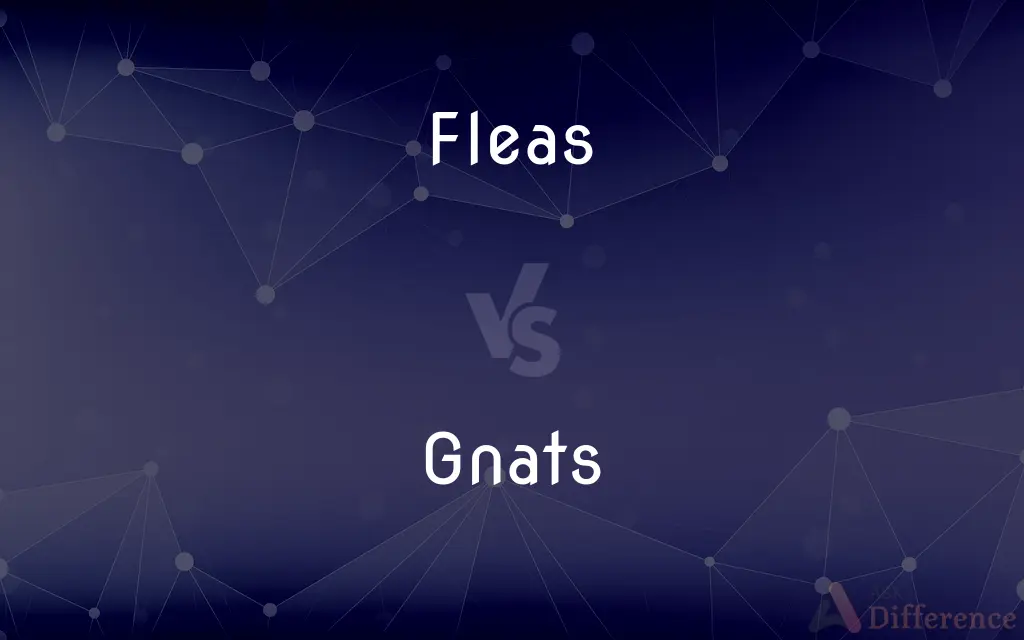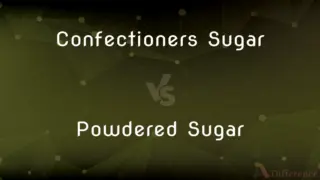Fleas vs. Gnats — What's the Difference?
Edited by Tayyaba Rehman — By Fiza Rafique — Published on December 22, 2023
Fleas are tiny, jumping insects that feed on blood, commonly found on pets. Gnats are small flying insects, often seen in swarms, that don't bite all species.

Difference Between Fleas and Gnats
Table of Contents
ADVERTISEMENT
Key Differences
Fleas are minuscule, wingless insects that are notorious for biting and feeding on the blood of mammals and birds. Gnats, on the other hand, are small flying insects that can often be seen hovering in groups or swarms, particularly near water sources or decaying organic matter.
Fleas are particularly problematic for pet owners. Their bites can lead to itching and discomfort, and in some cases, transmit diseases. Gnats, conversely, may not always bite. Some species of gnats are harmless, simply being nuisances, while others might bite and cause skin irritations.
In terms of physical attributes, fleas have strong hind legs designed for jumping great distances relative to their size. This is how they often move from host to host. Gnats, possessing wings, can fly and are often drawn to light, making them common evening pests around outdoor lamps.
Lifespan and reproduction also differentiate fleas and gnats. Fleas can live for several months, laying their eggs on hosts, which then drop off into the environment. Gnats have shorter lifespans, and their eggs are typically laid on the surface of stagnant water or moist soil.
Fleas are often considered more of a direct threat to household pets due to their biting nature and potential for disease transmission. Gnats, while less directly harmful, can still be an annoyance especially when found in large numbers, and some species can indeed be biters causing discomfort.
ADVERTISEMENT
Comparison Chart
Wings
Wingless
Winged
Feeding
Feed on blood
Some species bite, others don't
Movement
Jump using strong hind legs
Fly
Reproduction
Lay eggs on hosts
Lay eggs on stagnant water or moist soil
Associated Issues
Itching from bites, potential disease transmission
Annoyance in swarms, skin irritations from bites
Compare with Definitions
Fleas
Pests that can jump many times their body length.
Fleas can leap distances that are impressive for their tiny size.
Gnats
Small flying insects often seen in swarms.
The evening air was filled with gnats hovering around the lights.
Fleas
Carriers of various diseases, including the bubonic plague.
The spread of fleas was a significant factor in the historic plague outbreaks.
Gnats
Insects attracted to moisture, decaying matter, and light.
The stagnant pond became a breeding ground for gnats.
Fleas
Parasites commonly found on pets causing itchiness.
Regular grooming can help in detecting fleas on pets.
Gnats
Some species can bite and cause skin irritations.
I have several red spots from gnats' bites after the hike.
Fleas
Insects with a life cycle involving multiple stages including eggs, larvae, and adults.
The presence of flea larvae indicates a growing infestation.
Gnats
Often mistaken for fruit flies or other small bugs.
I thought they were fruit flies, but they were actually gnats.
Fleas
Small wingless jumping insects that feed on blood.
The cat was infested with fleas after its outdoor adventure.
Gnats
Have a shorter lifespan compared to many insects.
Gnats have a brief life but can be quite bothersome during their existence.
Fleas
Any of various small, wingless, bloodsucking insects of the order Siphonaptera that are parasitic on mammals and birds and can jump long distances.
Gnats
Any of various tiny two-winged flies, especially those that sometimes form swarms.
Fleas
Any of various small crustaceans that resemble or move like fleas, such as the water flea.
Gnats
Plural of gnat
Fleas
Plural of flea
Fleas
Infl of flea
Common Curiosities
How can I prevent fleas on my pets?
Regular grooming, flea treatments, and maintaining a clean environment can help prevent fleas.
Can fleas transmit diseases?
Yes, fleas can transmit various diseases, including bubonic plague.
Why do I see gnats around my plants?
Gnats are attracted to moisture and can often be found near overwatered plants.
What are fleas?
Fleas are tiny wingless insects that feed on blood, primarily from mammals and birds.
How can I tell if my pet has fleas?
Common signs include excessive scratching, red patches on skin, and visible fleas or flea dirt.
Do fleas jump or fly?
Fleas jump; they do not have wings and cannot fly.
Are gnats harmful to plants?
Some gnats, like fungus gnats, can damage young plants by feeding on their roots.
Do all gnats bite?
No, only certain species of gnats bite; others are just nuisances.
How do I get rid of gnats in my home?
Remove their breeding grounds, like overwatered plants, and consider using gnat traps or sprays.
Are gnats and fruit flies the same?
No, while they may look similar, gnats and fruit flies are different insects.
How long can fleas live?
Fleas can live for several months, depending on the environment and access to a host.
Can both fleas and gnats be treated with the same repellent?
Not always. While some repellents might deter both, it's essential to choose a product specific to the pest in question.
What attracts gnats to humans?
Body heat, moisture, and carbon dioxide emitted by humans can attract gnats.
How do gnats reproduce?
Gnats lay their eggs on the surface of stagnant water or moist soil.
Can fleas live on humans?
While fleas prefer animal hosts, they can bite and temporarily reside on humans.
Share Your Discovery

Previous Comparison
Confectioners Sugar vs. Powdered Sugar
Next Comparison
Lean Six Sigma vs. Six SigmaAuthor Spotlight
Written by
Fiza RafiqueFiza Rafique is a skilled content writer at AskDifference.com, where she meticulously refines and enhances written pieces. Drawing from her vast editorial expertise, Fiza ensures clarity, accuracy, and precision in every article. Passionate about language, she continually seeks to elevate the quality of content for readers worldwide.
Edited by
Tayyaba RehmanTayyaba Rehman is a distinguished writer, currently serving as a primary contributor to askdifference.com. As a researcher in semantics and etymology, Tayyaba's passion for the complexity of languages and their distinctions has found a perfect home on the platform. Tayyaba delves into the intricacies of language, distinguishing between commonly confused words and phrases, thereby providing clarity for readers worldwide.













































